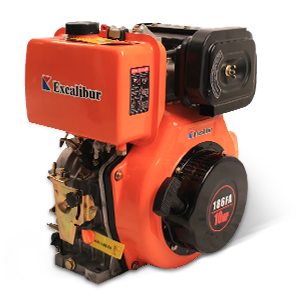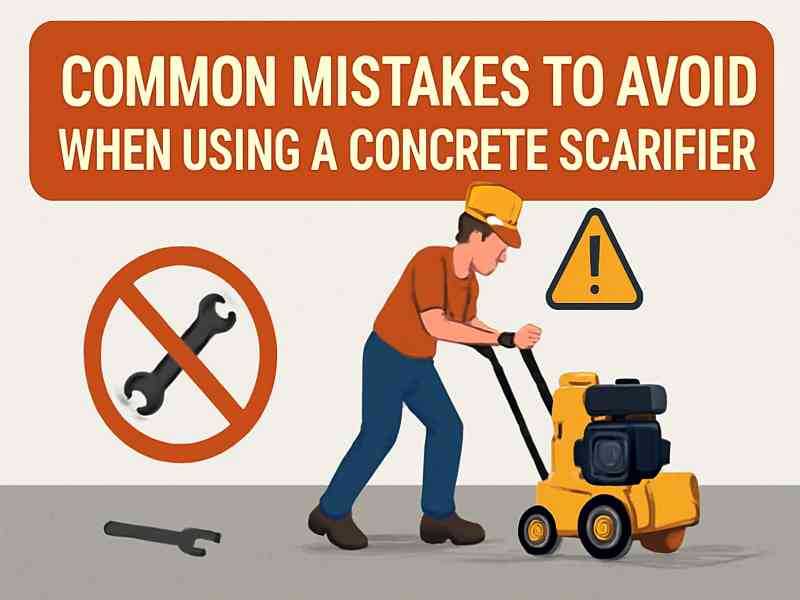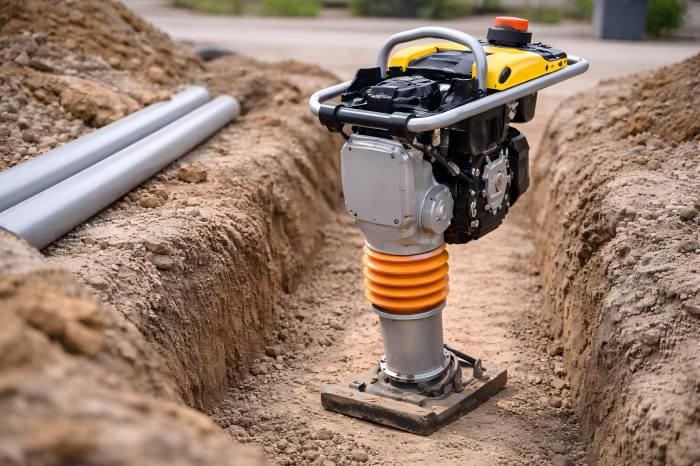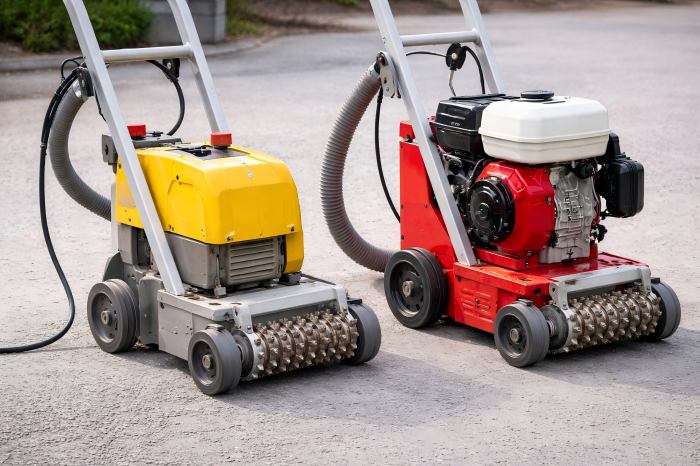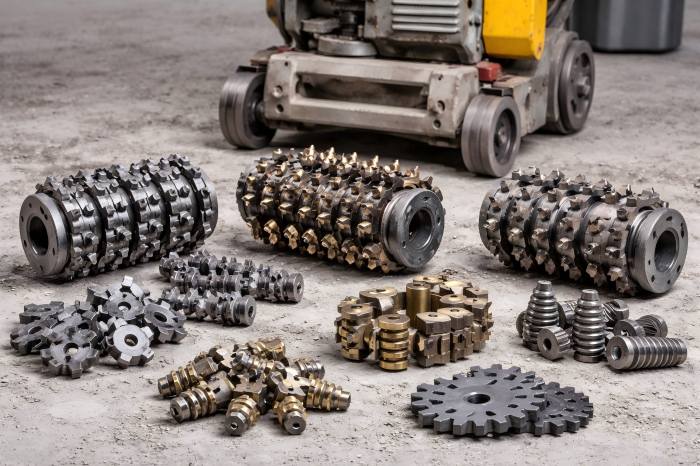Concrete scarifiers are commonly used in construction, industrial, and resurfacing projects to level uneven surfaces, remove coatings, or prepare concrete for further treatment. While concrete scarifiers are powerful and efficient, improper use can result in costly mistakes, safety hazards, and suboptimal results.
Choosing the Wrong Scarifier for the Job
Selecting the incorrect concrete scarifier for the job at hand is one of the most frequent errors. Scarifiers come in several varieties, and each is made for a particular set of materials and jobs. To guarantee successful outcomes, it is crucial to comprehend the many kinds of scarifiers and choose the appropriate one.
Types of Concrete Scarifiers:
- Walk-behind Scarifiers: These are the most common and are used for small to medium-sized jobs. Ideal for surface prep, coating removal, and leveling floors.
- Ride-on Scarifiers: These are larger and more powerful, used for larger industrial or commercial jobs. They handle heavy-duty tasks and are ideal for large areas.
- Handheld Scarifiers: These are smaller and ideal for precision work or small jobs such as grinding edges, corners, or other tight spaces.
Mistake to Avoid: Using a handheld scarifier for large surface areas or opting for a ride-on scarifier for a small, confined space can lead to inefficiency, poor results, and additional strain on the operator.
Comparison of Scarifier Types
| Scarifier Type | Application | Ideal Use Case | Advantages | Disadvantages |
| Walk-behind Scarifier | Small to medium surfaces | Surface preparation, coating removal | Good for most general jobs | Not suitable for large areas |
| Ride-on Scarifier | Large, industrial surfaces | Heavy-duty applications | Higher productivity | Less maneuverable in tight spaces |
| Handheld Scarifier | Small areas, edges, corners | Precision grinding | Great for tight spaces | Less power and speed |
Improper Setup and Calibration
Setting up a concrete scarifier properly is crucial for ensuring efficient performance. Failing to calibrate the scarifier’s depth or width settings can result in uneven surface preparation, excessive wear on the machine, and reduced overall efficiency.
Common Setup Mistakes:
Incorrect Depth Settings: Scarifiers have adjustable depth settings that control material removal. A depth that is set too shallow could result in insufficient surface preparation, while a depth that is set too deep could result in excessive removal.
Wrong Cutter Configuration: Different tasks may require different types of cutter heads, such as drum cutters or disc cutters. Using the wrong cutter for the material or task can result in poor surface finish and excessive wear on the machine.
Mistake to Avoid: Before starting the job, always double-check the depth settings and cutter configuration. For example, when removing a thick coating, a deeper setting with the appropriate cutters is essential, while lighter surface preparation may require a shallower setting.
Scarifier Depth
| Task | Recommended Depth Setting | Potential Issues from Incorrect Depth |
| Coating Removal | 1-2 mm | Too shallow: incomplete removal, too deep: uneven surface |
| Surface Preparation | 0.5-1 mm | Too shallow: ineffective preparation, too deep: excessive wear on machine |
| Heavy Grinding or Scarifying | 2-5 mm | Too shallow: inefficient, too deep: uneven surface finish |
Neglecting Surface Preparation
Surface preparation is a critical aspect of using a scarifier. Many operators overlook the importance of proper surface preparation before using a scarifier, which can lead to inefficient operation, poor surface finish, and unnecessary wear on the machine.
Key Considerations:
Remove Loose Debris: Before using the scarifier, ensure that the surface is free of debris, loose dirt, or dust. These materials can clog the machine and interfere with the scarifying process.
Moisture Content: Using a scarifier on a wet surface can result in reduced efficiency and a less consistent finish. Concrete surfaces should be dry to ensure the best results.
Mistake to Avoid: Skipping surface cleaning or using a scarifier on a wet or debris-filled surface can lead to subpar results, increased wear on the machine, and operational inefficiencies.
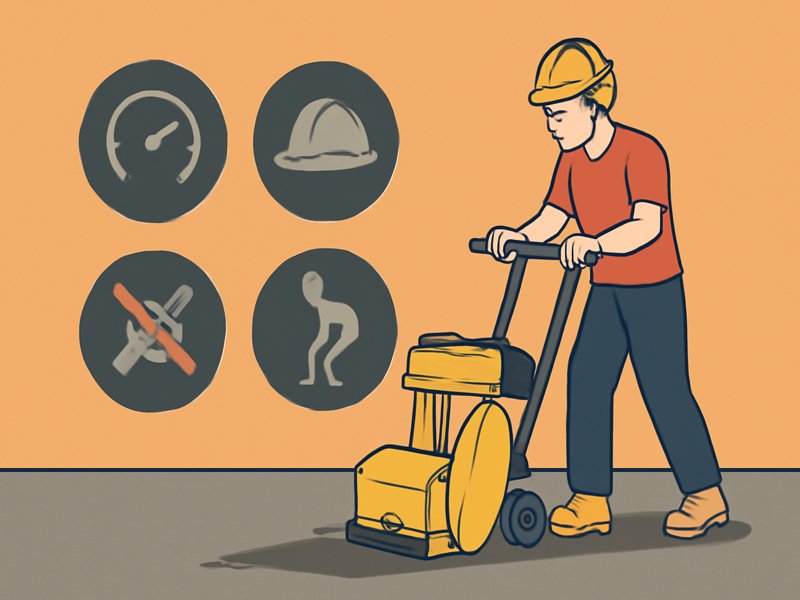
Failure to Maintain the Scarifier
Regular maintenance is vital for keeping the concrete scarifier in top working condition. Neglecting maintenance can cause breakdowns, high repairs, and poor performance.
Key Maintenance Practices:
Inspect the Cutter Drum or Discs: Regularly inspect the cutter drum or discs for wear and tear. Replace them when they become dull or damaged to maintain consistent performance.
Check for Loose Parts: Tighten all bolts, nuts, and screws, as loose parts can cause vibrations and lead to damage over time.
Clean the Scarifier After Each Use: Dirt, dust, and debris can build up, particularly around the motor and cutter head.
Mistake to Avoid: Neglecting regular inspection, cleaning, and maintenance can result in expensive repairs, decreased performance, and safety risks.
Basic Scarifier Maintenance Checklist
| Maintenance Task | Frequency | Purpose |
| Inspect Cutter Drum/Discs | Before and after each use | Ensure sharpness and minimize wear |
| Check for Loose Parts | Weekly | Prevent vibrations and ensure stability |
| Clean Scarifier (Motor & Cutter) | After each use | Prevent debris buildup and machine overheating |
Incorrect Operator Technique
The skill and technique of the operator play a significant role in achieving optimal results when using a concrete scarifier. Improper technique can lead to uneven surfaces, excessive wear on the machine, and inefficient use of time and materials.
Common Operator Mistakes:
Uneven Pressure: Applying too much pressure or forcing the machine can lead to uneven surface preparation. It can also cause unnecessary wear on the cutter heads and reduce the overall lifespan of the machine.
Incorrect Speed: Operating the scarifier too fast or slow can harm surface quality; adjusting speed ensures optimal results.
Not Following a Pattern: Scarifying the surface in random directions can result in uneven wear and an inconsistent finish.
Mistake to Avoid: Always allow the machine to operate at its designed speed and apply uniform pressure across the surface. Follow a consistent pattern and let the scarifier work naturally.
Neglecting Safety Precautions
Concrete scarifiers are powerful and potentially hazardous machines. Ignoring safety guidelines can result in serious injuries or accidents on the job site. Always prioritize safety during operation.
Essential Safety Tips:
- Inspect the Area for Hazards:Before starting, check for hazards like electrical cables, uneven flooring, or obstructions that may interfere.
- Proper Machine Handling: Ensure the scarifier is in good condition, with no loose parts, and follow safety guidelines.
Mistake to Avoid: Failing to follow proper safety protocols, including using appropriate gear and inspecting the work area, can result in accidents and injuries.
Essential Safety Gear for Concrete Scarifier Operation
| Safety Gear | Purpose |
| Safety Goggles | Protect eyes from flying debris |
| Hearing Protection | Reduce exposure to loud operating noise |
| Dust Mask | Protect from inhaling harmful dust. |
| Gloves | Shield hands from cuts and vibrations. |
Using a concrete scarifier can be an efficient way to prepare and repair concrete surfaces. However, avoiding the common mistakes outlined in this article is crucial for ensuring optimal results, maintaining the longevity of the machine, and preventing safety hazards. By selecting the right scarifier, calibrating the machine correctly, preparing the surface properly, maintaining the equipment, using proper technique, and following safety precautions, you can achieve high-quality results and improve the efficiency of your project.

